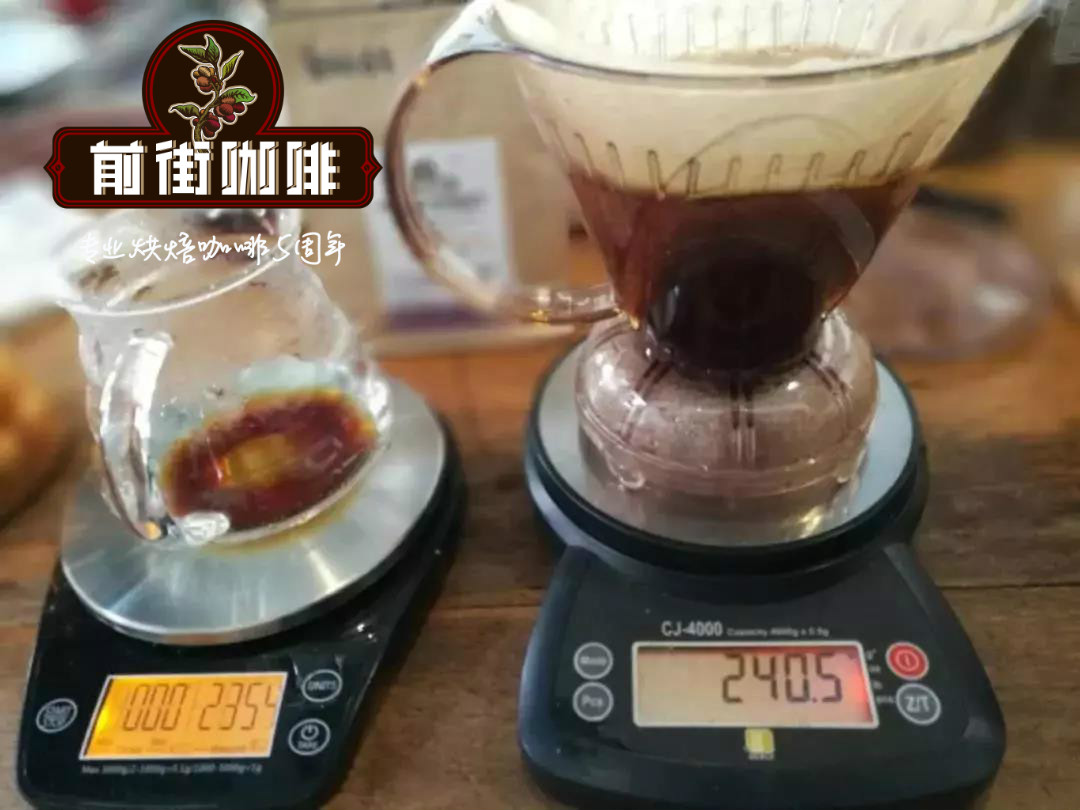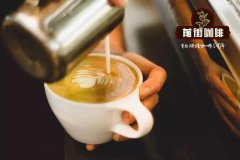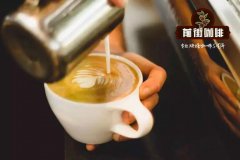How to extract coffee? Learn about extraction before making good coffee!

Professional coffee knowledge exchange more coffee bean information please follow the coffee workshop (Wechat official account cafe_style)
Want to improve the flavor of coffee? Everything becomes easier when you learn about extraction. You can effectively adjust the acidity, sweetness and balance of the coffee by brewing to achieve a satisfactory flavor each time.
This article tells you why you need to care about the degree of grinding, water temperature, powder bed distribution and other conditions.
What is extraction?
To put it simply, extraction is the process of dissolving flavor and aromatic substances from roasted and ground coffee powder. When coffee is brewed, hundreds of substances are extracted from coffee powder into water.
These substances extracted into the water will have a direct impact on the flavor and aroma of coffee. Substances that are soluble in water during the extraction process usually contain, but are not limited to, the following substances:
Caffeine
Sour (negative sour taste that may produce stinky acid, or positive sour that turns sweet)
Grease (viscosity)
Sugar (sweetness, consistency)
Carbohydrates (consistency, bitterness)
As long as you can understand how these substances are extracted, you can make good coffee more stably.
How does extraction affect the taste?
The substances in coffee are not extracted at the same rate and time, the first is the flavor and acidity of the fruit, the second is the sweetness and balance, and the last is the bitter taste.
Under-extracted coffee will not have a sweet taste, bitter taste will not be enough to support the balance of coffee, may have a smelly sour taste.
Over-extracted coffee will have a strong bitter taste, while substances that produce sweetness and acidity may be masked by bitterness.
But as long as the extraction is controlled, the flavor of the coffee can be balanced.
What is the perfect extraction?
You may have heard of the extraction rate, and some people measure the "total dissolved solid TDS" as the basis for the extraction results, which is simply how many substances are extracted from coffee to water, usually between 18% and 22%.
But remember that each kind of coffee has its own flavor characteristics, instead of pursuing specific "perfect data", focus on extracting the substances that make the coffee delicious.
How to control extraction?
In order to get the best flavor of coffee, you need the correct extraction rate.
If your coffee doesn't taste right, you can remove the obstacles you encounter as long as you know how to control the extraction.
Is the coffee too sour? It may be a lack of extraction, causing you to drink more acid in your coffee. Try to lengthen the brewing time or grind the coffee a little bit.
Is the coffee too bitter? It may be excessive extraction, try to grind the coffee a little bit, or shorten the brewing time to slow down the extraction.
Unstable extraction should also be avoided, which means that the extraction rate of some coffee powder should not be relatively high, resulting in the result of insufficient extraction and excessive extraction of the brewed coffee. This can also cause problems because you can't control or copy the flavor of the cup.
You can adjust the extraction to adjust these undesirable factors. If the coffee beans are kept for a long time, you can grind the beans finer to speed up the coffee extraction rate and make the coffee flavor more complete.
Deep-roasted beans are more likely to dissolve because the roasting time is longer and the structure of coffee beans is looser. Just remember that the extraction of deep-roasted coffee is thicker than that of light-roasted coffee.
Factors affecting extraction
The solubility and extraction will be affected by many factors, excluding the uncontrollable factors such as the variety characteristics of coffee. What we can adjust is the grinding thickness, water temperature, cooking method and so on. Let's take a look at how these variables affect extraction and coffee flavor.
Variable factor one: grinding thickness
1. The finer the grind, the faster the coffee is extracted, because the surface area of the powder in contact with water increases.
two。 Fine grinding may make the extracted coffee bitter because a large number of substances are extracted quickly.
3. Rough grinding may make the coffee insipid because there is not enough extracted material to support the coffee flavor.
Finely ground coffee powder has a smaller gap, which means that hot water flows through less space. If you use hand-dripping coffee, it will take longer to brew, so you need to reduce the amount of powder. This can also achieve the same effect by prolonging the cooking time, and it does not have to be ground.
Finer powders are also more vulnerable to water flow, which means that when brewing coffee, special attention should be paid not to let the fine coffee powder be piled too high by the water. when the small particles are affected by the water and are not soaked, these powders will not be extracted.
We must carefully choose the bean grinder, low-quality and cheap bean grinding will form a lot of fine powder, if the fine powder is not screened out, it may make the coffee cloudy. These fine powders are extracted very quickly because the particles are too small, resulting in a lot of unpleasant flavors to be extracted.
Factor 2: cooking time
The longer the cooking time, the longer the extraction time, usually shorter cooking time will be sour, longer time will be more bitter, which is also the change of cooking methods.
Espresso usually uses a very short brewing time to press the water through the tight coffee powder, which is suitable for fine grinding, giving the water enough surface area to extract when it passes quickly through the coffee powder. The French filter kettle takes a long time to cook, so thicker grinding is generally recommended to slow down the extraction rate and avoid bitterness.
But these two examples are just common cases where the brewing time of espresso can be adjusted for a few seconds to have an effect on the extraction. It can also be used to make up for the lack of cooking time. Others will use medium grinding to brew French filter pots in pursuit of a more complex coffee flavor.
Factor three: water temperature and water quality
The ideal water temperature for brewing coffee is about 90 ℃. When the water temperature is close to boiling, it is easiest to dissolve the coffee flavor into the water.
When the water temperature is higher, the extraction speed will be faster. If the water temperature is too low, the extraction time will be prolonged, and some substances may not be extracted at low temperatures, which is why cold-extracted coffee takes a long time to make, and the taste of the same coffee is much softer than that of hot coffee.
The boutique Coffee Association recommends brewing coffee water, but the most important thing is that the pH is neutral and does not contain pollution factors that affect the flavor of coffee.
The minerals in the water help to extract coffee. Magnesium ion helps to extract fruit with stronger flavor, while calcium ion may increase the mellow taste. However, if there are too many minerals in the water, the extraction effect will be reduced and the flavor of coffee will be affected.
Commercial coffee has a filter. If you have doubts about the quality of the coffee, try using filtered water or commercially available bottled water to make coffee and compare the taste.
Factor 4: powder bed distribution
Whether using a hand brew or a coffee machine, brewing is extracted by pouring water into the powder bed of the coffee. The powder bed is just like other factors, the most important thing is stability / consistency.
If the coffee powder is unevenly piled up or soaked unevenly, the water will produce a channel effect as it flows through the coffee powder and extract the coffee in the path that produces the channel, rather than the rest. Because the water will flow to the place with the least resistance, it is the same as the espresso that needs to be filled and then extracted. If we do not fill it, the water will flow from the place with more air, resulting in uneven extraction.
The speed of water injection is too fast or the flow of water is irregular, which may cause some coffee powder to be washed to the height of the filter cup, and these high powders cannot be extracted because they are above the waterline. This usually happens on the fine powder of coffee, and when you inject water in the middle of the powder bed, so that the coffee powder is pushed by the water to the wall of the filter cup.
These are pushed high, and the powder that leaves the extraction environment cannot be extracted, resulting in inconsistency in each cooking. In order to avoid this situation, flatten the powder bed before brewing, or consider using drip water injection or stirring to ensure that the coffee powder is evenly soaked.
Pay attention to how deep the coffee powder bed is. Too shallow powder bed may lead to excessive flow of water and insufficient extraction. If the powder bed is too deep, it will allow water to come into contact with coffee for too long, resulting in excessive extraction.
The extraction combines a variety of factors, and if you adjust one factor, it may affect other factors. Understanding the operation of extraction will help you effectively control the flavor of your coffee and find out the diversity of coffee flavor through the adjustment of factors.
In conclusion, attention should be paid to grinding thickness, cooking time, water temperature, and any other factors that may affect the extraction. When you find a way that is right for you, try to copy these factors and keep the results of each cooking stable.
Or use this parameter as the basis of the cooking experiment. Consistent extraction is the key to delicious coffee, so that you are not afraid of rushing out a bad taste every time. Don't be afraid to adjust, try to make better changes.
Important Notice :
前街咖啡 FrontStreet Coffee has moved to new addredd:
FrontStreet Coffee Address: 315,Donghua East Road,GuangZhou
Tel:020 38364473
- Prev

How do beginners learn to draw flowers in coffee? Blend of extracted coffee and milk foam
Professional Coffee knowledge Exchange more coffee bean information Please follow the coffee workshop (the official Wechat account cafe_style Coffee Laihua shows the highly difficult professional technology during the coffee performance, while the innovative skills and difficult technology shown greatly shocked the coffee industry at that time and attracted public attention from the very beginning. All the people are deeply affected by coffee.
- Next

How to master coffee flower drawing? Basic knowledge of coffee flower drawing matters needing attention
Professional coffee knowledge exchange more coffee bean information Please follow the coffee workshop (Wechat official account cafe_style) the jacquard was originally beautified on the latte, originated in Europe and the United States in the coffee production performance. As a demonstration of difficult technology, it was a great shock to all the people in the coffee industry at that time. And the gorgeous skills are inhaled deeply.
Related
- What is the meaning of lactic acid fermentation with coffee bean treatment?
- How to judge the state of foam by sound?
- How does the latte pull out the unicorn pattern? Come to get for a little trick to improve the flower pull!
- Will flower pulling affect the taste of the latte?
- Do you know the history of coffee?
- The difference between honey treatment and sun washing what is raisin honey treatment?
- What kind of milk can a novice use to make coffee foam to keep the foam longer? The correct method and skills of milking tutorial sharing
- Why do washed coffee beans taste sour? Flavor characteristics of washed Coffee
- Introduction to the skill of how to practice the size and height of water injection around the circle of hand-brewed coffee
- How do beginners practice coffee flower drawing from scratch?

